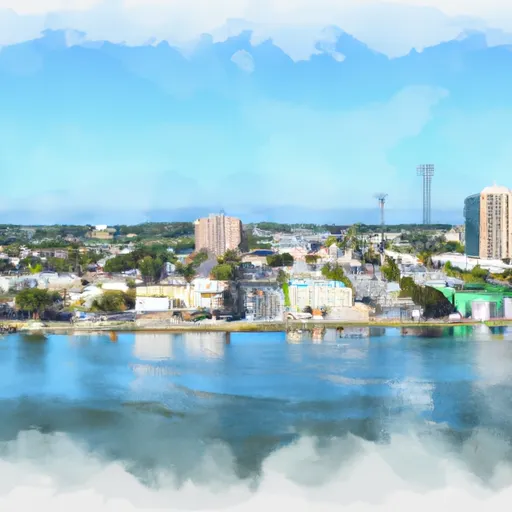-
 Snoflo Premium
Snoflo Premium
Get unlimited access to all our content
With no Ad interruptions! - Start Your Free Trial Login with existing account
Titusville
Eden Index
Climate
6.7
•
Recreation
6.6
•
Community
2.5
•
Safeguard
5.6/10

Titusville, Florida is a charming city located along the east coast of the state. Known for its beautiful weather and proximity to the Atlantic Ocean, Titusville experiences a pleasant subtropical climate. Summers are hot and humid, with temperatures averaging around 90°F (32°C), while winters are mild and comfortable with average temperatures around 70°F (21°C). The region receives abundant rainfall throughout the year, with the wettest months being June through September.
Titusville benefits from its location near several water bodies, including the Indian River Lagoon and the St. Johns River. These hydrologic constituents provide opportunities for various outdoor activities such as boating, fishing, kayaking, and paddleboarding. The city is also home to numerous parks and nature preserves, including the Merritt Island National Wildlife Refuge, where visitors can enjoy hiking, birdwatching, and wildlife spotting. Additionally, Titusville is renowned for being the gateway to the Kennedy Space Center, offering unique experiences such as rocket launches and educational exhibits about space exploration. With its favorable climate and diverse outdoor recreation opportunities, Titusville is a fantastic destination for nature enthusiasts and adventure seekers alike.
What is the Eden Index?
The Snoflo Eden Index serves as a comprehensive rating system for regions, evaluating their desirability through a holistic assessment of climate health, outdoor recreation opportunities, and natural disaster risk, acknowledging the profound impact of these factors on livability and well-being.
Climate Health Indicator (CHI): 6.7
Titusville receives approximately
1377mm of rain per year,
with humidity levels near 88%
and air temperatures averaging around
22°C.
Titusville has a plant hardyness factor of
9, meaning
plants and agriculture in this region tend to thrive here all year round.
By considering the ideal temperature range, reliable water supplies, clean air, and stable seasonal rain or snowpacks, the Climate Health Indicator (CHI) underscores the significance of a healthy climate as the foundation for quality living.
A healthy climate is paramount for ensuring a high quality of life and livability in a region, fostering both physical well-being and environmental harmony. This can be characterized by ideal temperatures, reliable access to water supplies, clean air, and consistent seasonal rain or snowpacks.
Weather Forecast
Streamflow Conditions
East Florida Coastal
Area Rivers
East Florida Coastal
Snowpack Depths
East Florida Coastal
Reservoir Storage Capacity
East Florida Coastal
Groundwater Levels
Recreational Opportunity Index (ROI): 6.6
The Recreational Opportunity Index (ROI) recognizes the value of outdoor recreational options, such as parks, hiking trails, camping sites, and fishing spots, while acknowledging that climate plays a pivotal role in ensuring the comfort and consistency of these experiences.
Access to outdoor recreational opportunities, encompassing activities such as parks, hiking, camping, and fishing, is crucial for overall well-being, and the climate plays a pivotal role in enabling and enhancing these experiences, ensuring that individuals can engage in nature-based activities comfortably and consistently.
Camping Areas
| Campground | Campsites | Reservations | Toilets | Showers | Elevation |
|---|---|---|---|---|---|
| Hatbill County Park | None | 11 ft | |||
| Wickham Park | 88 | 31 ft | |||
| Manatee Cove Military - Patrick AFB | None | 6 ft | |||
| Kissimmee Prairie State Park | None | 68 ft | |||
| Manatee Hammock Park | 177 | 18 ft |
Catastrophe Safeguard Index (CSI):
The Catastrophe Safeguard Index (CSI) recognizes that natural disaster risk, encompassing floods, fires, hurricanes, and tornadoes, can drastically affect safety and the overall appeal of an area.
The level of natural disaster risk in a region significantly affects safety and the overall livability, with climate change amplifying these risks by potentially increasing the frequency and intensity of events like floods, fires, hurricanes, and tornadoes, thereby posing substantial challenges to community resilience and well-being.
Community Resilience Indicator (CRI): 2.5
The Community Resilience Indicator (CRI) recognizes that education, healthcare, and socioeconomics are crucial to the well-being of a region. The CRI acknowledges the profound impact of these elements on residents' overall quality of life. By evaluating educational resources, healthcare accessibility, and economic inclusivity, the index captures the essential aspects that contribute to a thriving community, fostering resident satisfaction, equity, and social cohesion.

